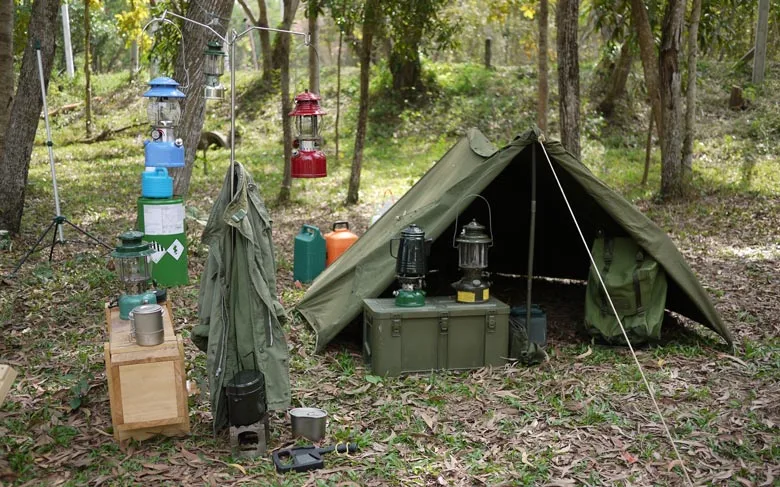Most of us are familiar with “pup tents” or “shelter-half.” However, this appears to be a new term in the world of tents for many people. So, to unriddle your confusion about the matter, we have come up with this blog post that focuses on elaborating on what is a pup tent and its brief history.
Before World War II, the U.S. Army had already invented an inhabitable temporary shelter. Those shelters, also called pup tents, were lightweight and quick to set up, precisely what the troops were looking for at that time.
The rudimentary purpose of those tents was to provide easy-going transportability to the troops. As a result, some infantry could lessen their burdens of accessories while spanning from one place to another. However, the utility terms of pup tents have extended so much over the years that even casual campers enjoy packing such styles of tents for their entertainment programs.
Table of Contents
What is a Pup Tent?
People looking for an easy-to-setup, simple-to-carry, and temporary-shelter type of tent should opt for a pup tent during their outer excursions. Unlike the old ages, tent manufacturers have innovated the modern version of these tents for recreational camping.
A quality pup tent is mainly designed to have a tiny basic structure. It doesn’t go all the way to different room sections inside. But one can easily adjust their accommodation for mild weather camping. You can also store your camping gear in such tents while enjoying one of your week-long camping activities.
While old versions of an actual tent used to be about 3.5 feet in height, 5 feet wide, and 7 feet long, the modern tent size now gets up to 12 feet. Also, modern pup tents have been updated to include waterproofing so you can stay dry during your night stay.
Pup tents are an excellent piece of gear for light outdoor enthusiasts. Kids planning to arrange a backyard camping can also use this assembly shelter as they are easy to carry, set up, and move. They aren’t like larger tents that need a flat, large area to set up multiple sections. They weigh just ten pounds. So you don’t have to worry about them weighing you down while you’re on the move.
What is the Name Origin of a Pup Tent?

There are a few different origin stories for “pup tent.” The most famous tale points to American Civil War troops, who supposedly called these tents “dogs.” It was a slang word for them to use on their accessories back in the time.
Although a more specific story suggests that Chattanooga Infantry soldiers used to refer to their tents as “doghouses,” which eventually transformed into the word “pup tent.” The latter seems more plausible. Both phrases are still used today for modern-style pups, particularly within the military.
An Insight into the History of Camping Pup Tent
The historical timeline of traditional pup tents started approximately 150 years ago. As mentioned earlier, the U.S. Army first invented these temporary shelters. Later on, the story went over many evolutions and changes. Thus, we’ll go through some of the most remarkable facts about pup tents in this segment.
American Civil War Pup Tents
During the American Civil and Revolutionary War, fellow comrades of the military troops needed shifting shelters. Their regular tent supplements were heavy at that time. So, it forced a difficult time on the infantry as some didn’t have their own conveyance.
They first planned to adjoin two half-pieces of clothes with a row of buttons for the pup tents. That way, it might not have offered them solid protection from the inclement weather. But the best part was that it provided them with more than just water resistance at the top. It prevented condensation, too!
In the 19th century, their invented pups had no doors or windows. The materials used to comprise the basic shelters were so weak that they couldn’t prevent flood penetration in heavy rain. Consequently, soldiers had to employ stable tree branches or army gear as props to prevent their tent’s breakage.
World War II Pup Tents
Tent poles evolved quite a bit throughout World War II. When armed forces initially developed their tent size, they sectioned them into three parts. They included a single wooden pole with a metal top instead of tent poles. This change made transportation more accessible and allowed others to use the poles differently.
Korean War Pup Tents
Cotton duck material became the standard tent fabric during the Korean War. Most tents featured army green poles and dark green fabric back then. Also, they used tent flaps in their shelter for the first time. Some of their tent flaps even included a “U.S.” date stamp and the contractor’s name.
Vietnam War Pup Tents
The United States Army created the modern pup tent design of A-frame tents during the Vietnam war. When soldiers realized they needed a comfortable place to stay while on deployment, they needed a solution that would fit more than one soldier.
The army’s solution was to create a larger version of the tent with two poles. They also ensured that their living accommodations had a mosquito net to keep mosquitoes away.
Modern Pup Tent Designs
Today’s tents have come a long way from their ancient times design. However, from its design premises, these tents are still the same. They are now sturdy, solid, and drier than their predecessors.
Today’s models comprise emergency materials that feature mildew and ample protection against inclement weather conditions. Besides, some advanced tents are made of environmental control ducts for winter camping. It allows the tents to maintain a suitable atmosphere inside the room for its inhabitants.
Wrapping Up
Today, pup tents are used in a variety of ways. If you live near the great outdoors, a pup tent is indispensable. It’s lightweight, portable, and perfect for camping, hunting, fishing, or other outdoor activities.
Pup tents are innovative gear built to protect people from the outer environmental elements. They’re lightweight, portable, and last for years. It makes them an excellent investment for any trip. Their low height makes them ideal for sleeping under the stars in your backyard or during a long hike.



